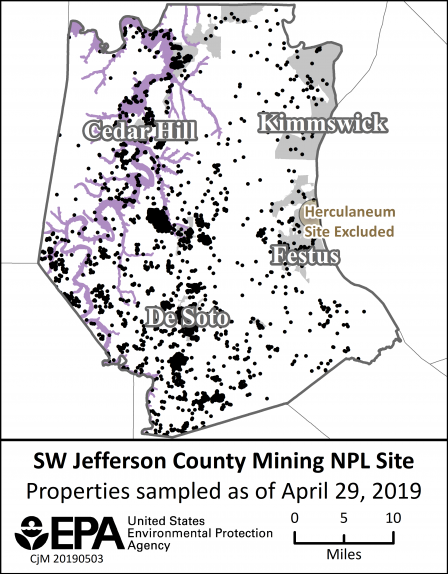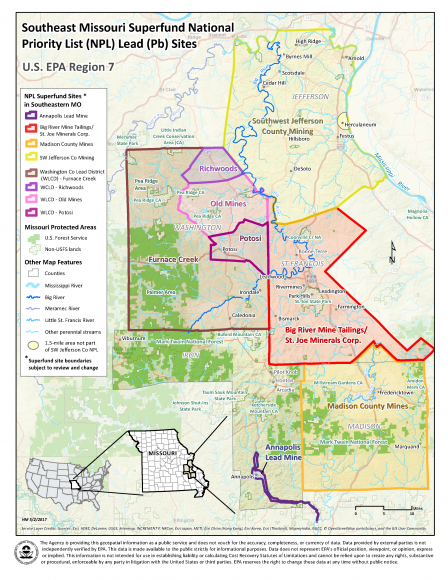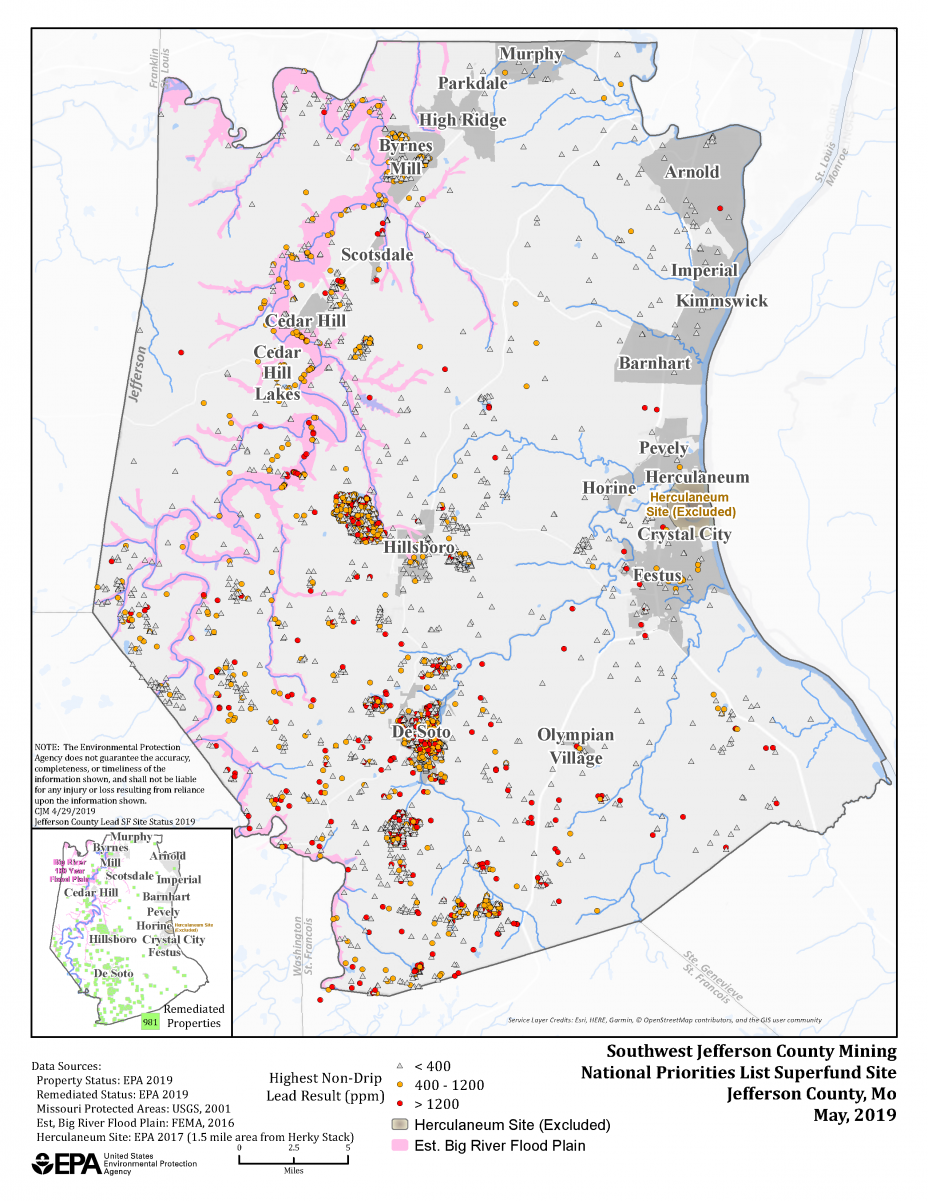Southwest Jefferson County Mining National Priority List (NPL) Superfund Site, Jefferson County, Missouri - Fact Sheet, January 2020
Open House/Public Availability Session Announcement and Site Update
Free Lead Testing for Residential Yards and Private Drinking Water Wells – Big River
EPA OPEN HOUSE ANNOUNCEMENT
 The U.S. Environmental Protection Agency (EPA) Region 7 is hosting an Open House/Public Availability Session for the Southwest Jefferson County Mining National Priorities List (NPL) Superfund Site (site). EPA and partner agency representatives will be available to meet with residents starting at 6:30 p.m. in an open house format. At 7:00 p.m., EPA will provide a site update presentation, after which EPA and its partners will resume meeting with residents at informational tables until 8:30 p.m. in the open house format.
The U.S. Environmental Protection Agency (EPA) Region 7 is hosting an Open House/Public Availability Session for the Southwest Jefferson County Mining National Priorities List (NPL) Superfund Site (site). EPA and partner agency representatives will be available to meet with residents starting at 6:30 p.m. in an open house format. At 7:00 p.m., EPA will provide a site update presentation, after which EPA and its partners will resume meeting with residents at informational tables until 8:30 p.m. in the open house format.
The public is welcome to attend any part of the two-hour session, which will be held:
Thursday, Jan. 23, 2020
6:30 to 8:30 p.m.
Hillsboro Community Civic Center (Jefferson County Fairgrounds)
10349 Highway 21
Hillsboro, MO 63050
EPA is committed to providing reasonable accommodations to individuals with disabilities. For a reasonable accommodation at the Open House/Public Availability Session, please contact Jonathan Cooper by email at: cooper.jonathan@epa.gov.
BACKGROUND AND SITE UPDATE
The Southwest Jefferson County Mining NPL Site is part of the Old Lead Belt in southeastern Missouri, which was one of the world’s largest lead mining districts. (See "Southeast Missouri" map below.) Mining began in the early 1700s and produced more than 8 million tons of lead. Extensive lead mining, milling and smelting activities contaminated soil, sediment, surface water, and groundwater with elevated levels of heavy metals, primarily lead, prompting the need for state and EPA involvement.
 The Big River flows north through the Old Lead Belt. Large amounts of mine waste containing heavy metals were deposited into the Big River watershed as a result of these mining activities. Federal, state and local agencies are working together to protect public health. So far, EPA has stabilized the major lead mining waste piles upstream of the river and floodplain and has initiated the cleanup of residential properties in many impacted areas of St. Francois, Washington and Jefferson Counties.
The Big River flows north through the Old Lead Belt. Large amounts of mine waste containing heavy metals were deposited into the Big River watershed as a result of these mining activities. Federal, state and local agencies are working together to protect public health. So far, EPA has stabilized the major lead mining waste piles upstream of the river and floodplain and has initiated the cleanup of residential properties in many impacted areas of St. Francois, Washington and Jefferson Counties.
In Jefferson County, EPA has sampled over 4,700 residential yards for lead contamination, and over 1,000 yards have been cleaned up since work began in 2007. (See "Properties sampled" site map above.) Many more properties are eligible for remediation. EPA aims to sample as many residential and child high-use areas as possible for potential lead contamination. Residential properties also include child high-use areas such as child care facilities, parks and playgrounds.
EPA is asking residential property owners for access to conduct free lead contamination sampling (testing) of residential yard soils and private drinking water wells. If your residential property has been tested and is eligible for remediation [400 parts per million (ppm) lead or higher in soil], EPA’s contractor will perform the cleanup for free.
In addition, approximately 1,275 private drinking water wells have been tested for elevated lead levels in the groundwater. EPA has provided bottled water to prevent residents from drinking elevated levels of lead in their well water. (See larger site map at the bottom.)
SEDIMENT AND SOIL IN THE BIG RIVER AND ITS FLOODPLAIN MAY HAVE HIGH LEVELS OF LEAD
If you own property along the Big River or within the Big River floodplain, EPA would like to conduct soil sampling (testing) on your property. Periodic flooding along the Big River can introduce contaminated river sediments to flooded properties. Even if you have had your property tested before, if your property has been flooded, it should be tested again.
To have your property sampled for potential lead contamination, please contact EPA’s Contractor, Tetra Tech, at 636-797-8446 to initiate the process. EPA will coordinate sampling activities to minimize any inconvenience to you.
SAMPLE MATERIAL BEFORE MOVING IT OFF-SITE
EPA is working with landowners in this area that borrow soil, sand or gravel or grow sod to prevent the possible spread of contaminated materials, especially to residential properties. Spreading highly contaminated material [above 400 parts per million (ppm) lead] in residential areas could result in harmful exposure to others and could be a violation of federal law.
If you engage in moving materials that are potentially contaminated, either as a business or private citizen, and are not already sampling on a regular basis, we strongly suggest that you contact EPA (see contact below) to develop a sampling plan that will help protect you and others.
REMEDIAL INVESTIGATION, FEASIBILITY STUDY, AND FIVE-YEAR REVIEW
EPA is currently conducting a Remedial Investigation (RI) to determine the full extent of mining-related metals contamination in the Big River and Big River floodplain, and to evaluate human health and ecological risk. Along with the completion of the RI, EPA plans to finish a Feasibility Study (FS) to evaluate remediation alternatives. Upon completion of the RI/FS, EPA will issue a Proposed Plan that will describe the evaluated cleanup alternatives and the proposed remedy.
EPA has started the First Five‐Year Review for the site. Five‐Year Reviews provide an opportunity to evaluate the site remedy to determine whether it remains protective of human health and the environment. This Five‐Year Review should be completed in June 2020.
ABOUT LEAD AND PUBLIC HEALTH
Lead exposure can cause a range of adverse health effects for children and adults, from lifelong behavioral disorders and learning disabilities to seizures. It is harmful if inhaled or swallowed. EPA classifies lead as a probable human carcinogen and is a cumulative toxicant.
Lead is particularly dangerous to children 7 years old and younger because their growing bodies absorb more lead than adults do, and their developing brains and nervous systems are more sensitive to the damaging effects of lead. Pregnant women and nursing mothers should avoid exposure to protect their children. It is important that children 7 years old and younger have their blood lead level tested annually. Talk to your child’s doctor or local health agency to arrange for blood lead testing/screening.
You can contact the Jefferson County Health Department by phone at 636-797-3737, or at one of these locations: Hillsboro, 405 Main Street; Arnold, 1818 Lonedell Road; or High Ridge, 5684 State Road PP.
PROTECT YOUR FAMILY FROM LEAD
-
Washing hands after playing outside and before meals.
- Regularly cleaning floors, window sills, and other surfaces. Use a mop or sponge with warm water and general all-purpose cleaner. Thoroughly rinse sponges and mop heads often during cleaning of dirty or dusty areas, and again afterward.
- Regularly washing children’s hands, bottles, pacifiers, stuffed animals, and toys. Keep play areas clean.
- Removing shoes or wiping soil from shoes before entering your home to avoid tracking in lead from soil.
EPA CONTACT INFORMATION
If you have questions, need additional information, and/or would like to receive site updates, contact EPA:
Lenexa, KS 66219
ONLINE RESOURCES
- Visit the Southwest Jefferson County Mining Site page
- EPA posts Fact Sheets for Missouri cleanup sites online
- CDC’s ATSDR Lead ToxFAQs™
- CDC’s Lead page
- EPA's Lead pages: www.epa.gov/lead and www.epa.gov/lead/learn-about-lead
- EPA’s Protect Your Family from Lead in Your Home
- EPA's Fight Lead Poisoning with a Healthy Diet
- EPA's Superfund Community Involvement page with technical assistance resources
- Fact Sheet, July 2019: Free Lead Testing and Residential Cleanup Opportunity, Protect Public Health and Prevent Lead Poisoning; The Big River and Floodplain - St. Francois, Jefferson and Washington Counties in Missouri
- Fact Sheet, May 2019: Lead Testing and Cleanup Opportunity, Residential Soils and Private Drinking Water Wells, Remedial Actions at the Site; Southwest Jefferson County Mining National Priority List (NPL) Superfund Site, Jefferson County, Missouri

